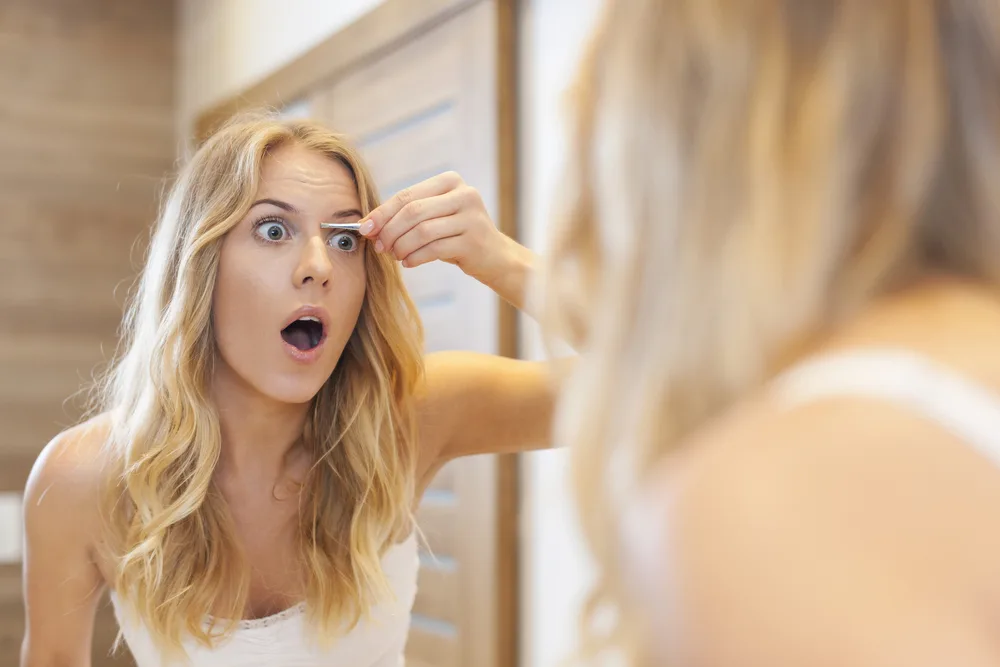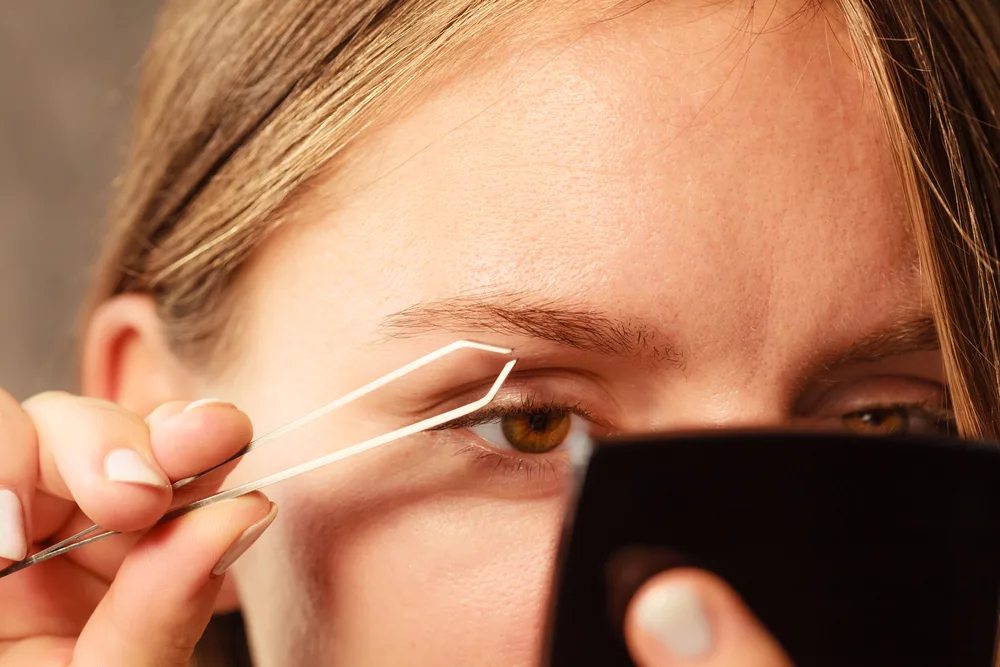Jump to:
Plucking hair is among the most prevalent and cost-effective methods of hair removal, but it isn’t always efficient, depending on how and where you do it. Read on to learn more about plucking hairs, including the dos and don’ts to consider.
What Is Hair Plucking?
If you are uncomfortable with stray hairs on your face, you have probably contemplated plucking them. But first, you may have some questions.
- Will the hair regrow?
- Is hair plucking harmful?
- How do I pluck a hair without causing damage?
- What are the alternatives to hair plucking?
We all have had these questions, especially if you are trying out hair plucking for the first time. With this in mind, we have highlighted all you need to know about hair plucking, giving you insightful tips on this popular hair removal method.
Do Plucked Hairs Grow Back?
Yes, plucked hair will regrow with time. In addition, studies on mice show that plucking hairs that are close together may stimulate growth.
Hair plucking, also known as tweezing, is a simple and affordable way to remove unwanted or stray hairs. This physical hair removal method is often used on facial hair, particularly eyebrows. \
Hair plucking entails removing individual hairs by grabbing each hair and tugging it from the root. Although relatively cheap, hair plucking isn’t always a safe and efficient way to get rid of hair if done incorrectly.
Tweezing may stimulate hair growth, so you want to do it correctly. Nevertheless, properly plucking hair is generally safe and offers long-lasting results than most hair removal methods, including shaving.
Plucking and Hair Growth
According to the NIAMS, hair follicles adjacent to each other provide a coordinated response to inflammation and damage resulting from hair plucking.
As a result, the follicles release a chemical that elicits an immune response by stimulating hair growth. However, this effect isn’t replicated if the hairs are far apart and well-fitting for stray hair removal.
When plucking, you’re targeting the follicles, and continuous plucking will damage the follicles, affecting hair regrowth. Therefore, plucked hair regrows slowly compared to shaving since it’s pulled from the roots.
Is Hair Plucking Harmful?
The effectiveness of hair plucking depends on the technique you employ and the body part.
The parts of the body that you can routinely pluck include:
- Underarm
- Eyebrows
- Nipples
- Chin
- Sideburns
- Knuckles
However, hair plucking can cause damage, depending on the body part. Some of the possible harms include permanent scars, possible infections, and inflammation.
The places you should think twice before plucking hair include:
Inside the Nose
The ultimate no-go zone for hair plucking is inside the nose. This is because the hair inside the nose is a barrier to infections and bacteria infiltration. If you have overgrown hair inside the nose, consider using sterilized nail scissors to trim it delicately.
Ingrown Hairs
You should also avoid plucking ingrown hairs, which can cause infections, scarring, and inflammation. Should you have ingrown hairs, seek remedy by visiting a dermatologist.
Read Next: How to Properly Remove an Ingrown Hair
On Pimples
Pimples are another no-plucking zone. Pus pimples around hair shafts can be a minor infection called folliculitis. In such a case, plucking hairs on the pimple can help remedy the illness.
Nevertheless, plucking hair can aggravate the condition by introducing bacteria to the affected area. Also, plucking hair on pimples can result in permanent scarring.
On Moles
Hair growth on moles is common, but plucking them can cause inflammation and infections. In addition, removing hairs on moles can be daunting.
Instead, you should consult a dermatologist for alternative hair removal methods. Typically, you can remove hair growth on moles by laser removal, trimming, or removing the mole.
Plucking Hair Without Causing Damage

gpointstudio/Shutterstock
Plucking isn’t entirely bad, and there are instances when it’s well-recommended. When done correctly, plucking removes the hair from the root, delaying regrowth for up to six weeks.
As a result, plucking may control hair growth more than other removal methods in most cases. Here are the tips to follow to safely pluck your hair without causing damage:
Always Use Sterilized Tweezers
Always use sterilized tweezers to pluck hairs safely and effectively, especially if you often use tweezers. Sterilizing helps to avoid spreading infections when plucking. In addition to sterilizing the tweezers before use, always keep them in a clean place.
Always Pull Hairs at an Angle
When plucking, always pull the hair towards the grain of the hair at an angle. Pulling hairs at an angle can help prevent the occurrence of ingrown hairs and minimize damage to hair follicles.
However, you must note that going against the grain will break the hair or skin. If you break the hairs, don’t proceed with tweezing, as it can cause skin infection and irritation.
Hold the Skin and Tweezers Tightly When Plucking
Finally, hold your skin tightly to ensure you are comfortable pulling out hairs. Also, firmly hold your tweezers to guarantee you get adequate support from your pluckers.
Alternatives to Hair Plucking
Keep in mind that plucking hair isn’t a permanent solution. Plucked hairs will grow again, and you’ll have to grow them again. There are well-recommended alternatives if you want to skip the hassles of plucking hair.
However, with many hair removal procedures available, finding the best fit for your needs can be overwhelming. But don’t be alarmed; we’ve got your back!
Shaving
Shaving is a quick and economical way to remove hair from the skin’s surface. This hair removal method is great for large surfaces, including legs, face, arms, and underarms.
However, while shaving is simple and quick, you’ll only remain hair-free for a few days. So, you’ll need to shave every few days.
Laser Hair Removal
Laser hair removal employs applying heat from a laser, targeting hair follicles. The procedure digs into the follicles and inhibits regrowth.
Nevertheless, you may have to repeat the procedure multiple times before the hair regrowth ceases altogether. Fortunately, you can use laser hair removal on any body part.
Waxing
You can perform waxing professionally or at home. Although painful, waxing is effective as it pulls several hairs out by the root using hot or cold wax. You can remove hair by waxing on any body part, leaving your skin hair-free for 2-4 weeks.
Frequently Asked Questions

Voyagerix/Shutterstock
Here are the FAQS about hair plucking.
How long does plucked hair take to regrow?
Hair plucking, when done properly, can last up to six weeks before the hair grows back. This duration can vary depending on how quickly your hair grows. Nevertheless, hair typically regrows after 2-6 weeks after tweezing.
Why does hair grow back after plucking?
When you pluck hair by the root, you won’t be taking out the follicle but the hair bulb visible at the base of the hair strand. So, plucking hair may temporarily damage the follicle, but a new bulb eventually emerges, and the hair strand regrows.
Can plucking permanently remove hair?
No, plucking offers a temporary hair removal solution but offers long-lasting results than most hair removal procedures.
What are the white bulbs at the base of plucked hair strands?
The white gooey substance that the base of hair strands has the name club hair, made up of a lump of keratin, a protein found in your nails, hair, and skin. The club hair helps root the hair strand in the follicle.
Is it okay to pluck pubic hair?
Yes, plucking is a low-risk way to eliminate unwanted hairs along the bikini line. However, the hair removal method can be time-consuming.
So, Do Plucked Hairs Grow Back?
Yes, plucking hairs isn’t a permanent solution to hair growth. Now you have answered the puzzle of whether plucked hairs grow back. So, you don’t have to worry if you accidentally pluck your hair, as it will soon start regrowing.
Nevertheless, if you seek to get rid of unwanted hair, consider choosing a hair removal method that fits your pocket needs, schedule, and preferences.
